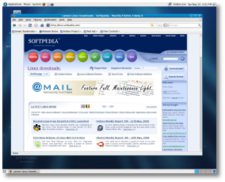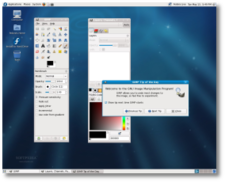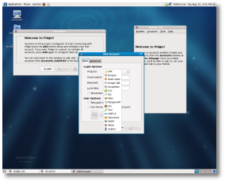This year on May 13th, Fedora 9 was released into the wild. Dubbed Sulphur, it introduced for the first time in the history of Fedora, support for encrypted filesystem (implemented in the graphical installer), PackageKit as the default graphical package manager, ext4 filesystem support and PreUpgrade, a tool that offers you the possibility to upgrade an existing Fedora 7 or 8 distribution. Being classified as a "bleeding edge" distro, and that's ONLY because the developers wanted to inject the brand new edition of the Xserver software (version 1.5), which is not compatible yet with the major proprietary video drivers, Fedora 9 brings you Linux kernel 2.26.25.3, KDE 4.0.3, GNOME 2.22.1, NetworkManager 0.7 with improved support for mobile broadband, multiple devices and wireless networking, Cheese (the popular webcam capture tool), Firefox 3 Beta 5 and a lot more other new applications!
Therefore, we wanted to know more about this Linux distribution and about the upcoming Fedora 10 release, so we've contacted the project leader, Paul W. Frields, for an in-depth interview. Paul W. Frields lives in Fredericksburg, VA USA, he is an engineer for Red Hat and was a founding member of the Fedora Project Board, where he served the community from April 2006 to July 2007. Paul took the Fedora Project Leader role in February 2008, from Max Spevack.
Softpedia: Is Fedora 9 a prelude for the next release, Fedora 10? If it is, how does it prepare the user for F10?
On the other hand, this release has seen the introduction of FreeIPA, and I'd expect to see an evolution of that capability in Fedora 10. By their nature, some features are planned on a multi-release schedule, and others accommodate a single-release schedule well. You can see more about our feature process at http://fedoraproject.org/wiki/Features/Policy.
Softpedia: We've found out that some improvements were made in X, so the start-up and shutdown process are much faster now. What exactly was changed in X?
Paul W. Frields: I'm not an X hacker, but you can find Adam Jackson's notes on this feature here on the Fedora wiki. Notice that our entire process is open and transparent. We don't make secrets out of our feature process or progress, but instead invite the community to learn about it and get involved! It's a great way to show that the open source philosophy can carry effectively into many different areas of our project.
Softpedia: Why did the init daemon get replaced with Upstart? What can Upstart do that init can't?
Paul W. Frields: A couple improvements include parallel startup capabilities, which is somewhat self-explanatory, and service dependencies. While the traditional init requires a careful organization of services so that the right things start first, Upstart has the ability to tie services together in bundles. So if you start a web server, Upstart has a way of "knowing" it needs to start your network too.
Softpedia: We've encountered some persons that had some problems enabling the proprietary drivers for their video cards, in Fedora 8, mostly because they were not too tech-savvy. How will Fedora 9 change this? If someone wants to enable these drivers and enjoy the effects provided by Compiz Fusion, can he/she do it in an easy way?
Paul W. Frields: To a great extent this is driven by the hardware manufacturers and not Fedora. For example, at Fedora 9's initial release, Nvidia card users are not able to enable proprietary drivers. It's easy to simply say that's because Nvidia didn't get their driver ready for the new Xorg that's available in Fedora, even though most developers believe there was plenty of time to do that before our release. (Although Fedora 9 currently features an Xorg 1.5 prerelease, drivers prepared for it would work fine with the final release).
The more complete answer is that a company's choice not to open source their drivers means the community can't help them with that work. Companies like Intel have already seen the huge benefit in open sourcing their drivers. It's not an accident that people using graphics like Intel's 965 have a great experience on Linux! Those drivers can be maintained in the FOSS community and updated along with the rest of the X stack. I consistently tell audiences that if you want to do something small to help FOSS, then vote with your money! Buy from manufacturers who support our community.
Softpedia: How does Fedora intend to compete with other projects without merely dividing and absorbing pieces of the same pie?
Paul W. Frields:Well, I should point out that FOSS isn't a simple competition; it's more like "co-opetition" - so adopting an "us vs. them" attitude ends up being not very constructive or healthy. It's much healthier to build FOSS by having a robust policy for dealing with upstream software communities. The Fedora policy of working closely and vigorously with these upstream groups means we're not just consuming that work, we're contributing to it actively. By comparison, simply creating patches in our own distribution creates a maintenance drag, as well as an uneven experience for FOSS users who work on a number of platforms. Having the software work differently on each distribution doesn't reassure users about how well FOSS works. When we find problems, we send the solutions, via patches and other forms, back to the upstream communities and work with them to get them included where they make sense. That improves FOSS for *everyone*, and not just Fedora.
And this isn't just Red Hat paid developers doing this work - we have literally thousands of active contributors, and only a small percentage, less than a quarter, are Red Hat employees. Two-thirds of our package maintainers are volunteer contributors, and they do a lot of work with upstream to make sure we're continually aiding in the improvement of the software for everyone.
Softpedia: How does Fedora intend to overtake Ubuntu?
Paul W. Frields: Interestingly, this question assumes that Fedora's goals, and the way we achieve them, are exactly the same as Ubuntu's. Like Ubuntu, we have millions of users. We're able to report that, based on the entirely open source technologies we use for our project. The key to Fedora's strategy is realizing that doubling our number of users doesn't help advance free and open source software as much as doubling the number of active contributors. The work those contributors do creates a far better experience with Linux, and that work reaches audiences through many channels besides just the Fedora Project. Some technology examples include NetworkManager, PackageKit, IcedTea and OpenJDK 6, and ext4. You can see these technologies in distributions other than Fedora, which shows the impact this "culture of contribution" idea is having across FOSS.
Softpedia: Is there a possibility that someday we will see a course for beginners about Fedora?
Personally, I don't see much of a market in *commercial* firms producing Fedora training, because our six-month release cycle makes it very difficult to balance out the quality assurance on that training with the very frequent updates required. But the great thing about Fedora is that it's contributor driven, so if a community forms around producing this kind of course, we have all the pieces in place in Fedora to support it.
Paul W. Frields: I think the two questions of release cycle standardization and distribution collaboration are separate issues. I think much more value is derived by standardizing the way that we interact with the upstream FOSS communities who provide the software that goes into distributions. This is one of the main driving forces behind Fedora's upstream policy: http://fedoraproject.org/wiki/PackageMaintainers/WhyUpstream.
If every distribution follows a policy of interacting continuously and consistently with upstream, developers are free to continue innovation at their own pace. They can be certain that they have an unobstructed channel for feedback from the users and other
When one distribution produces patches that don't go to the upstream communities, either because they aren't good code or because there's no existing policy, both the users and the maintainers ultimately lose. The maintainers start to shoulder an ever-increasing burden of backporting and bug triage. To make matters worse, users encounter problems when they expect similar behavior from distro to distro or release to release, or when they try to connect with upstream communities for help or file bugs. And ultimately, developers will not be interested in being involved in that kind of a situation.
Softpedia: There is a growing trend of embedding Linux distributions on mobile devices and even on motherboards (ASUS did this with Splashtop). Does Fedora make things easier than other distros when it comes to embedding or installing it on such platforms?
Paul W. Frields: The tools we have for remixing our distribution in a way that's free and legal for anyone, anywhere certainly makes Fedora compelling from that perspective. It's very easy for people who are doing appliance building, or just about any other work that demands easy customization, to make Fedora work for them in a given footprint. The extensive work we've done in both the desktop user space and in areas like X and the kernel are going to have payoffs in the mobile space too. Beyond the technical details though, it's important to have a true community effort around this kind of work to make it successful as an open source venture. I think Fedora is doing that in a balanced way while driving fast-paced innovation to an unprecedented extent, and staying true to its mission of advancing FOSS.
Softpedia: Which aspects of Fedora are you going to concentrate on in Fedora 10?
Paul W. Frields: This is something we're coalescing right now. One of the things I think you're definitely going to see in Fedora is improvement in the way contributors can interact with our websites and other capabilities. We recently rolled out a new account system (https://admin.fedoraproject.org/accounts) and have a new MediaWiki coming in the next few days that uses that single sign-on capability. I expect we'll have many more of our sites tying together like that, and we'll also be working on strengthening our QA and release processes to make Fedora 10 our best release yet.
Softpedia: Thank you so much for the interview, Paul.
Paul W. Frields: Thanks for the opportunity to talk to you more about the Fedora Project.
For those of you who want to try this great Linux distribution, Fedora 9 can be downloaded from Softpedia.

 14 DAY TRIAL //
14 DAY TRIAL // 

